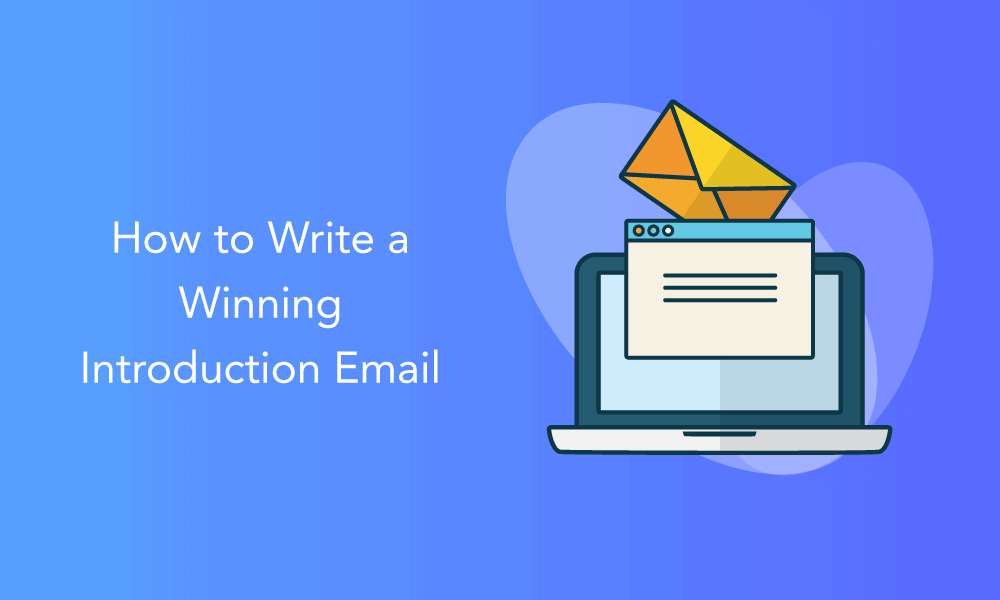Many companies spend considerable effort and time on building an email database, but spend very little energy maintaining it.
If a prospect has allowed you entry into their inbox, you have to make sure that they don’t revoke that permission.
Once someone joins your subscriber list, you should focus your energy on making sure they stay there. This is where sending a welcome email helps. Think of it as your readers’ first impression of your company’s content.
The average person receives about 120 emails daily. Only 16.97% of people care to open the emails they receive. To guarantee future opens of your emails, you need to get the first one right — the introduction email.
In today’s post, we’re going to break down the basics of an introduction email — what it is, why it’s important, and how a great email introduction can help your overall marketing results.
Table of Contents
Why Send an Introduction Email?
An introduction email should be part of your company’s broader email marketing strategy.
It’s important to remember that your customers probably already have tons of marketing emails in their inboxes. If you send a cookie-cutter, generic email from an email template, chances are they will unsubscribe at the first chance.
In this case, your welcome email should offer your subscribers something: think of it as offering something in return for getting their contact information.
Freebies or resources like this are called lead magnets. They can be effective in acquiring, retaining, and converting more subscribers into paying customers.
Other benefits of a good email introduction include:
- Setting clear expectations
- Improving email deliverability
Most emails are neither opened nor read. One of the reasons? Excessive email sending frequency.
Informing your new subscriber of your email sending frequency is an email marketing best practice. It is also an effective way to limit spam complaints and unsubscribes from your email list.
Writing and sending an introduction email can prevent your future emails from entering spam or promotions folders. In turn, this improves your email deliverability.
Wondering how you’ll do it? Simple. Provide email whitelisting instructions.
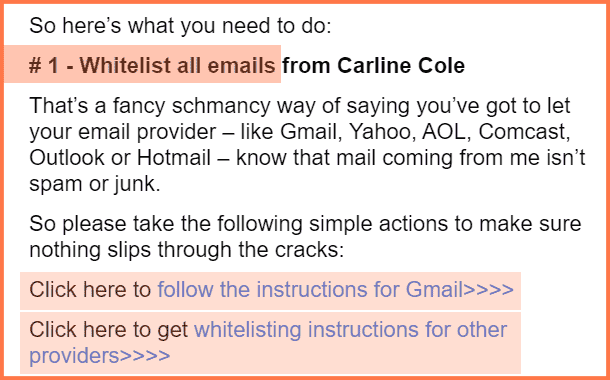
You could also highlight the benefits of whitelisting your email to your new subscribers.
For instance, they don’t get to miss emails with exclusive deals and valuable information.
6 Essential Elements of a Winning Introduction Email
Every time a customer reads your email, they’re building an impression of your company in their mind. If your initial impression isn’t great, they’re not going to feel inclined to engage with your business.
Remember that just like you, your readers can also tell when they see an email from an email template 😉
For the TL;DR on the essential elements of a welcome email, check out the video below.
Whether your strategy involves sending one introduction email or a multi-email campaign, keep these tips in mind.
#1. Optimize your subject line
Before writing an epic introduction email, consider your email subject line.
A good email introduction should be interesting enough for the reader to feel compelled to read more. You’re not going to reach that point if your subject line doesn’t catch their eye.
Your email subject line helps the reader decide if your business introduction email should be opened and read. A boring email subject line implies a boring email message, and by extension, a poor customer experience.
Take a look at this awesome email subject line from Pipedrive:
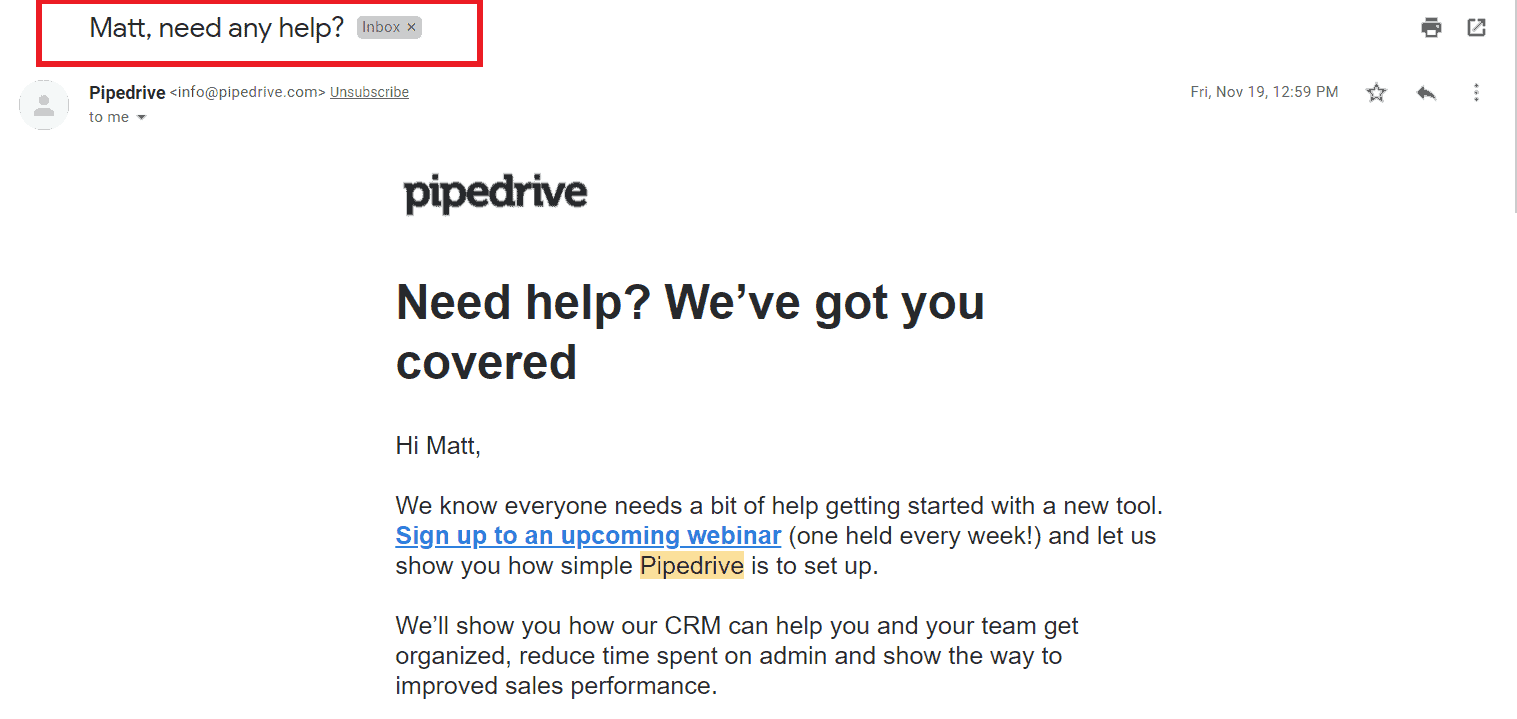
You can see that the email subject line is personalized, crisp, and to the point. It doesn’t confuse the reader and doesn’t keep them in the dark about what the email is about.
Straight away, the email subject line makes it clear that the reader can open it to find some guidance on setting up or using Pipedrive. That’s a great example of a winning subject line.
So, how can you get maximum value from your email subject lines? By A/B testing.
Email A/B testing helps you to evaluate your best-performing subject lines quantitatively. You do this by sending the same email with different subject lines to 2 groups of your new subscribers.
| Percentage of new subscribers | Subject line | Email open rate |
| 20% | You’re in! Here are a few vital details | 10% |
| 20% | You’re in – See what’s next …? | 23% |
After the timeline for the A/B test elapses, the winning subject line is used for the remaining recipients.
If you’re using a CRM system like EngageBay, you can automate the entire process and measure results more effectively.
Read more: 25 Creative Email Subject Lines To Boost Open Rates
#2. Thank them for subscribing
This is the part where you can reaffirm their decision to subscribe to your company’s content and contribute to growing your email list. Thanking your subscribers not only makes them feel like they’re part of a community, it also helps build deeper trust in your brand.
Thanking your new email subscribers makes you likable and it humanizes you and your brand.
When new email subscribers sense that you appreciate them for joining your email list, they will remember your company name, because nobody forgets those who appreciate them!
Read more: Introduction Email Mistakes You Don’t Want to Make
#3. Introduce yourself with panache
This is your chance to shine by saying what you do.
Introduction emails can be used to build a mutual connection with your subscribers. Use this space to talk about your company and its values. You can expand on it by telling a story or an anecdote; it often makes it easy for new readers to relate to you.
What if you don’t want to follow the storytelling route? You could write an introduction email that shows you’re an authority in your niche.
Whichever route you choose for your email introduction, the goals remain the same; a fun introduction email that cements your authority and allows you to connect deeply with your new email subscriber and a potential client.
Note: This strategy works for a cold email just as well!
Here’s an email that can serve as a brilliant example of both an introductory email and a welcome email. It’s from Brian Dean, Founder of Backlinko:
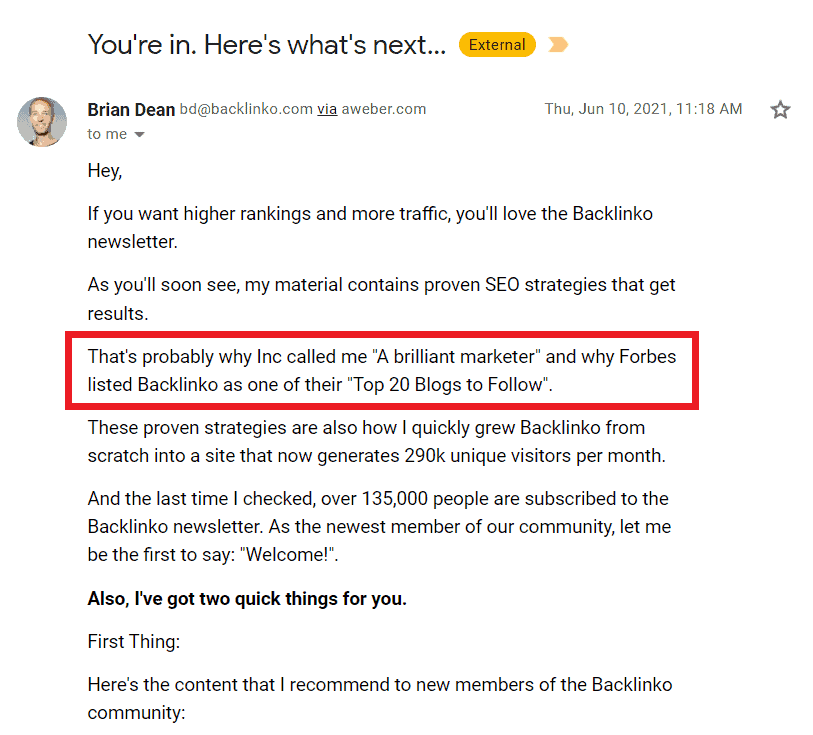
Related blog: 4 Introduction Email Examples Worth Replying (and Why)
#4. Deliver on your promises
New subscribers can get on your email list in various ways — like a newsletter sign-up or a social media referral link.
If you acquired customers by promising them access to a resource or an incentive, don’t forget to follow up on it.
Failing to deliver on what you promised is a breach of trust, and you risk losing your customers.
Expert Tip: Test gated and ungated lead magnets to see what works best.
- Gated lead magnet: You require the subscriber’s email for them to receive your resource.
- Ungated lead magnet: The lead magnet is available for free download. Add a link to your subscription form within the lead magnet and invite the reader to subscribe if they love your resource.
This strategy helps you know how valuable your resource is to your new email subscribers.
👉Learn the art of saying ‘sorry for the inconvenience’ in a more empathetic and professional way. Explore our guide for tips and templates.
#5. Let them know what to expect
We mentioned earlier in the article how important it is to set clear expectations.
Your readers should know what they can expect when they open an email.
You should also be upfront about the kind of content that you’ll send, the frequency of the emails, and how your subscribers will benefit from them.

The above email sent by BBC is a great example of informing the recipient of what they can expect.
You can also ask for feedback in a follow-up email. This is especially helpful for small businesses that are trying to build engagement.
Obviously, not all your readers will respond but you can gain a lot of insight from the ones that do:
- Why and how your new subscriber engages with your brand
- The depth of brand loyalty in your audience
- How targeted your content is
- Previously unidentified pain points of your audience
All of this information helps you refine your marketing arsenal and prepare your new subscribers as a conversion-ready audience.
#6. Include a Call-to-Action (CTA)
Like every marketing goal, the ultimate aim of your introduction emails is for your new subscriber to take action.
Adding a clear CTA to your self-introduction email makes this possible. It also gives your subscribers new ways to stay engaged with your company.
Whether you link to your social media profiles, or send redeemable coupon codes, CTA buttons can increase click-through rates.
Here are extra tips for writing and designing introduction email CTAs:
- Ensure the color of your CTA button contrasts with your email background. This makes it noticeable.
- Use lots of white space around your CTA button.
- Keep the length of your CTAs short, especially when using buttons.
- Use a mix of naked text links, anchor text, and buttons.
- Keep your CTAs to a minimum. One is fine. Two is okay. Three is going overboard.
- Assuming you want your new subscriber to download something, your naked text links, anchor text, and buttons should lead to that resource.
Note: These tips need not be restricted to emails for your subscribers alone. If you need to send cold emails, these tips will help just the same.
Read also: A Quick Guide to Email Signatures and Best Practices
How to Make The Most of a Welcome Email (3 Tips)
Let’s look at some email hacks that can help you win at writing welcome or introduction emails.
1. Send Emails in a Series
Instead of sending just one introductory email, consider splitting your welcome emails into a series.
That way, you can send multiple messages (with different end goals) to your subscribers and increase engagement. Multi-series emails also help solidify customer relationships.
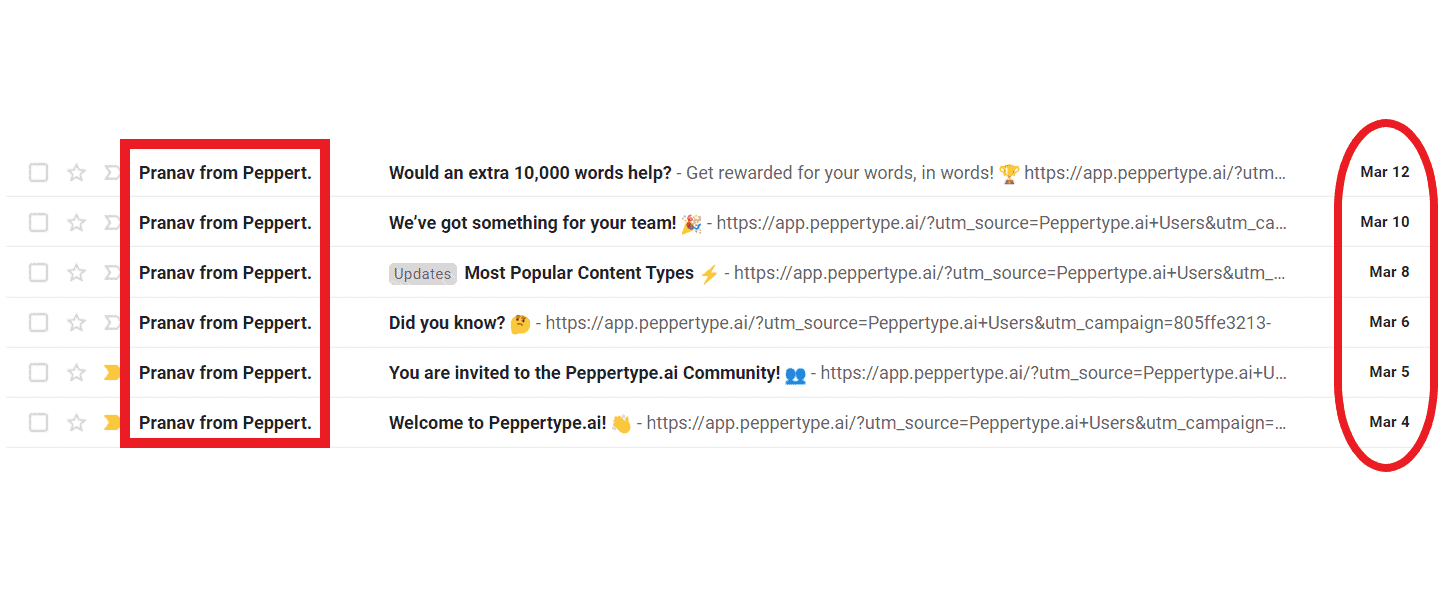
According to data, welcome email series generate more revenue, on average, than a single introduction email.
It’s safe to assume that you’re vying for a small piece of real estate in your customer’s inbox.
If you send just one welcome email, it could get buried. Sending a follow-up email or two can help get noticed in a brimming inbox.
Multi-series emails enable you to build several communication touchpoints.
You can also automate the entire process by pre-drafting and scheduling your introduction email drip campaigns, so you don’t risk ghosting your new customers.
2. A/B Test Everything
The data doesn’t lie. You can only know what’s working by testing it.
Test your CTA buttons, text link, email subject line, CTA placement, email message, email signature, headers and footer, images, and so on.
Once you find what works, stick to it. You can save all those elements as your own custom email template, and use it whenever you need to send out another introduction email.
Email marketing software like EngageBay can help you A/B test your emails at incredibly affordable costs.
Read also: 11 Mailchimp Alternatives and Why You Should Consider Them
3. Use Audience Segmentation
Your subscriber list is never going to be homogeneous: you’ll get new leads and customers from different channels and they’ll have different requirements.
Audience segmentation helps you send targeted, personalized emails for building stronger connections.
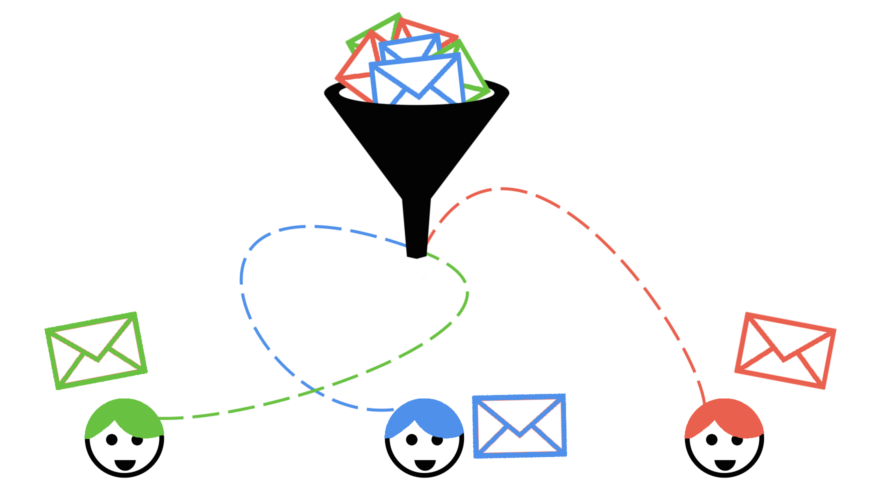
You can segment your audience based on location, past consumer behavior, email addresses, contact information, or broader demographics.
Audience segmentation strategies help you create professional email messages that are relevant, which in turn, inspires more subscribers to take action.
You can use customer relationship management (CRM) software like EngageBay to segment your email list based on predefined criteria.
You can create sales email templates, segment lists, and track email links for further analysis.
Read also: ECommerce Welcome Emails: Dazzle, Delight, Convert [Examples & Templates]
Wrap Up
If you want to make first impressions count, you have to start by giving new subscribers a warm welcome.
Introduction emails are a great opportunity to build customer relationships, explain your brand’s philosophy, and increase customer conversions.
There are several ways to build an introduction email template and the one you choose depends on your brand goals and philosophy.
No matter which template you use, the core of your strategy should always be customer-centric. Proofread your emails to make sure that your customers connect and find some value in the content you’re sending.
And finally, set up your introduction email sequence (for free) with an easy-to-use and affordable tool like EngageBay to help you roll out the red carpet for new subscribers.
👉Get your daily dose of marketing humor with these 11 relatable email memes! 😆

